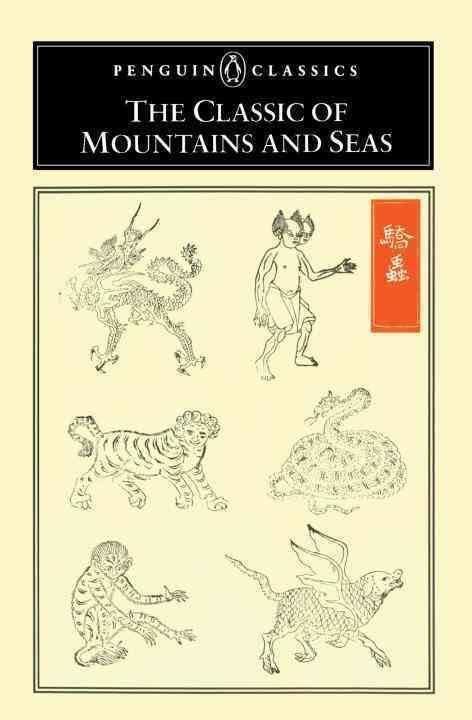9 /10 1 Votes9
Traditional Chinese 山海經 Hanyu Pinyin Yale Romanization Saan-hoi Ging | 9.1/10 Viki Simplified Chinese 山海经 Wade–Giles Shan-hai Ching | |||||||||||||||||||||||||||||||||
 | ||||||||||||||||||||||||||||||||||
Literal meaning Classic of Mountains and Seas Similar Records of the Grand Historian, In Search of the Supernatural, Strange Stories from a Ch, Classic of Poetry, Commentary on the Water Cla | ||||||||||||||||||||||||||||||||||
The Classic of Mountains and Seas or Shan Hai Jing, formerly romanized as the Shan-hai Ching, is a Chinese classic text and a compilation of mythic geography and myth. Versions of the text have existed since the 4th century BC, but the present form was not reached until the early Han dynasty a few centuries later. It is largely a fabulous geographical and cultural account of pre-Qin China as well as a collection of Chinese mythology. The book is divided into eighteen sections; it describes over 550 mountains and 300 channels.
Contents
Authorship
The exact author(s) of the book and the time it was written are still undetermined. It was originally thought that mythical figures such as Yu the Great or Boyi wrote the book. However, the consensus among modern Sinologists is that the book was not written at a single time by a single author, but rather by numerous people from the period of the Warring States to the beginning of the Han dynasty.
The first known editor of the Classic was Liu Xiang from the Western Han, who among other things cataloged the Han imperial library. Later, Guo Pu, a scholar from the Western Jin, further annotated the work.
Overview
The book is not a narrative, as the "plot" involves detailed descriptions of locations in the cardinal directions of the Mountains, Regions Beyond Seas, Regions Within Seas, and Wilderness. The descriptions are usually of medicines, animals, and geological features. Many descriptions are very mundane, and an equal number are fanciful or strange. Each chapter follows roughly the same formula, and the whole book is repetitious in this way.
It contains many short myths, and most rarely exceed a paragraph. A famous ancient Chinese myth from this book is that of Yu the Great, who spent years trying to control the deluge. The account of him is in the last chapter, chapter 18, in the 2nd to last paragraph (roughly verse 40). This account is a much more fanciful account than the depiction of him in the Classic of History.
Purpose
Earlier Chinese scholars referred to it as a bestiary, but apparently assumed it was accurate. In fact the information in the book is mythological. It is not known why it was written or how it came to be viewed as an accurate geography book.
Contents
The Classic of Mountains and Rivers has 18 chapters (巻). Chapter 4 has 12 subsections (次一), 2 and 4 have four, and chapters 1 and 3 have three.
All 18 chapters can be classified into 4 categories: Classic of the Mountains (contents 5 chapters), Classic of the Seas (contents 8 chapters), Classic of the Great Wilderness (contents 4 chapters), and Classic of Regions Within the Seas (contents 1 chapter). It recorded more than 100 diplomatically related realms, 550 mountains and 300 rivers, along with the geographic and cultural information of the nearby realms. The Classic of Mountains and Seas also recorded up to 277 different animals. Scholars believe the records of animals in Classic of the Mountains are somewhat exaggerated due to the long history of people compiling them in different dynasties; yet they still have a certain degree of authority, because they were generally written by sorcerers and Fangshi based on the experiences they gained from their trips.
The ancient Chinese treated the Classic as a record of geography. The Classic was classified under the category of geography in both Book of Sui and Comprehensive Examination of Literature of Duanlin Ma. It was also an important reference material of Chinese historians through the long history of China.
The Classic of Mountains and Seas is also the source and origin of the ancient Chinese mythology. Some of them are popular and well known in Asian culture, such as Kua Fu, Nüwa, Houyi and Yellow Emperor. There were up to 450 gods and deities mentioned in Classic and they used something called Jingmi (精米) or Jing (糈) which is similar to sorcery.
Chinese scholar Ming Hua Zhang claimed that the Zhulong, which was a mythical creature mentioned in Classic of the Great Wilderness: North, is symbolizing the aurora (northern light). The Zhulong is (according to Classic) "red, with a human face and a snake body that is thousand mile long. It is the god of Zhong Mountain." He believes that this description matches with the characteristics of aurora.
